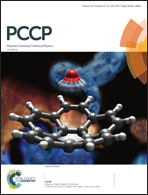Influence of cosolvents, self-crowding, temperature and pressure on the sub-nanosecond dynamics and folding stability of lysozyme†
Abstract
We studied the effects of temperature and hydrostatic pressure on the dynamical properties and folding stability of highly concentrated lysozyme solutions in the absence and presence of the osmolytes trimethylamine-N-oxide (TMAO) and urea. Elastic incoherent neutron scattering (EINS) was applied to determine the mean-squared displacement (MSD) of the protein's hydrogen atoms to yield insights into the effects of these cosolvents on the averaged sub-nanosecond dynamics in the pressure range from ambient up to 4000 bar. To evaluate the additional effect of self-crowding, two protein concentrations (80 and 160 mg mL−1) were used. We observed a distinct effect of TMAO on the internal hydrogen dynamics, namely a reduced mobility. Urea, on the other hand, revealed no marked effect and consequently, no counteracting effect in an urea–TMAO mixture was observed. Different from the less concentrated protein solution, no significant effect of pressure on the MSD was observed for 160 mg mL−1 lysozyme. The EINS experiments were complemented by Fourier-transform infrared (FTIR) spectroscopy measurements, which led to additional insights into the folding stability of lysozyme under the various environmental conditions. We observed a stabilization of the protein in the presence of the compatible osmolyte TMAO and a destabilization in the presence of urea against temperature and pressure for both protein concentrations. Additionally, we noticed a slight destabilizing effect upon self-crowding at very high protein concentration (160 mg mL−1), which is attributable to transient destabilizing intermolecular interactions. Furthermore, a pressure–temperature diagram could be obtained for lysozyme at these high protein concentrations that mimics densely packed intracellular conditions.



 Please wait while we load your content...
Please wait while we load your content...